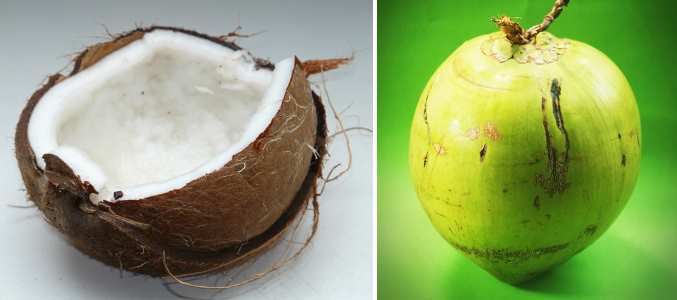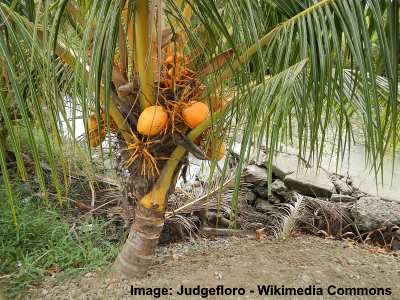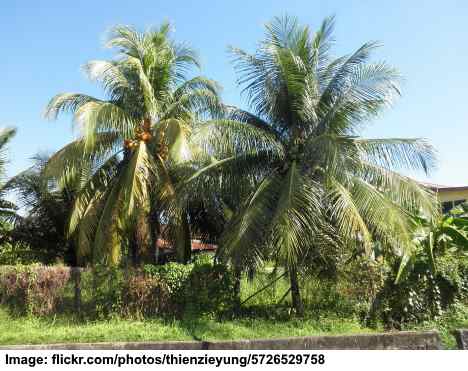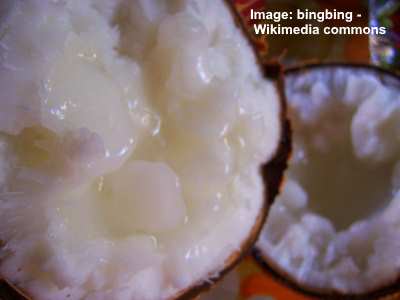Types of Coconuts: Green, Brown, White and More Varieties from Around the World (With Pictures and Names)
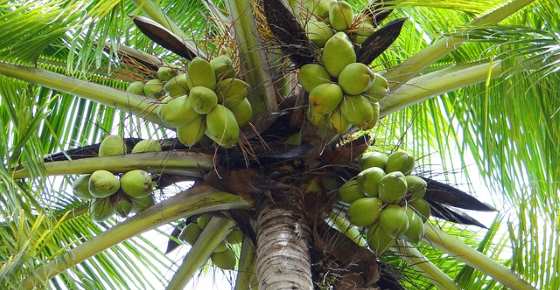
Coconuts are a type of tropical fruit that grow on coconut palm trees. There are 2 basic varieties of coconut palms – tall palm trees and shorter dwarf varieties. These palms produce coconuts that can be in various shades of green, brown, and yellow. Types of green coconuts are young coconuts that are full of delicious coconut water. Brown varieties of coconuts are mature and contain white coconut flesh.
Coconut palms grow in countries in the world that have warm humid climates all year long. Generally, for coconut trees to produce fruit, they need a constant temperature of at least 64°F (17°C). That is why coconuts grow in places such as the Pacific islands, Florida, California, Brazil, tropical Asia, and the Philippines.
Actually, all parts of the coconut palm and the coconut fruit are very useful. For example, coconut oil is good for cooking, applying to your skin, and has other uses. Coconut water is also a good source of minerals and hydration.
In this article, you will learn about the various varieties of coconuts from around the world.
Is Coconut a Fruit, Nut, or Seed?
The short answer is that a coconut could be all three – a nut, seed, and a fruit. Botanists say that coconuts are classified as a fibrous one-seeded drupe. Every coconut has an outer layer, fleshy middle part, and a hard layer around the seed. (1)
White Coconut vs. Brown Coconut
White coconuts are not different varieties from brown coconuts. The color classification of the coconut is due to its level of maturity.
Young coconuts have a white husk under their green outer skins. Stripping off the outer skin reveals this soft husk. Inside the white coconut is soft, almost gelatinous meat that doesn’t taste of anything. However, white, or young coconuts, contain delicious and nutritious coconut water.
Brown coconuts can refer to the type of coconut you usually buy in the store. A hard, hairy brown shell and inside is firm, fibrous white flesh that has a distinct tropical taste. Brown coconuts also contain some coconut water. You can eat the flesh of brown coconuts raw, grate it in desserts, or toast shavings.
There are also other types of white coconut. Unlike brown coconuts, the white varieties have a white hard hairy shell rather than the traditional brown type.
Main Coconut Varieties (With Pictures and Names)
All varieties of coconut are actually from a single species Cocos nucifera. The difference between different kinds of coconuts is usually due to the type of coconut palm the fruit is from.
Tall coconut varieties
Varieties of tall coconuts are the type that are typical of tropical island beaches or lining streets in hot countries. Tall coconut trees can grow to between 50 and 80 ft. (15 – 24 m) tall and produce coconuts after 6-10 years. The most common 2 types of tall coconuts are West Coast Tall and East Coast Tall.
The fruits from tall varieties of coconuts are generally medium to large. On the tree, their outer skin can be orange, yellow, green, or brown.
Dwarf coconut varieties
As you would expect, varieties of dwarf coconuts are much smaller than the enormous tall varieties. However, the name “dwarf coconut” can be misleading. Some types of dwarf palms can still grow as high as tall varieties of coconuts. These can be called “semi-dwarf coconut” varieties.
Dwarf coconut trees grow between 20 and 60 ft. (5 – 18 m) and produce fruit from as little as 2 to 3 years. Apart from the difference in size, dwarf coconut palms produce fruit that is smaller than tall coconut varieties. These dwarf “nuts” are usually green, yellow, or orange types of coconuts.
One of the reasons for growing dwarf varieties of coconut is that their fruit generally grows closer to the ground. This makes it easier to harvest the hard nut-like fruits.
In warm humid climates, dwarf coconut palms can make an attractive feature in a large garden.
Hybrid coconut varieties
Hybrid types of coconut tend to be hardier and produce more fruit than tall or dwarf varieties. Usually, types of hybrid coconuts are a cross between a tall coconut palm and a dwarf coconut palm. This produces a hardier type of coconut that is resistant to diseases such as Lethal Yellowing.
The most common type of hybrid coconut is the Malayan dwarf. This coconut palm produces medium-sized yellow-green coconuts.
Types of Coconuts (With Pictures and Names)
Let’s look in more detail at some of the various kinds of coconuts that grow in the world.
East Coast Tall Coconuts
The East Coast Tall variety of coconut can grow to be a high tree and each palm produces in around 70 coconuts a year.
Coconuts from the East Coast Tall variety are usually medium-sized green coconuts. The East Coast coconuts are rich in coconut oil and its fleshy content may contain nearly 65% oil. This tall type of coconut palm thrives in hot weather and sandy loamy soil.
West Coast Tall Coconuts
Another tall variety of coconut is the West Coast Tall palm. This type of coconut has a yield of around 80 coconuts per year.
Compared to East Coast coconuts, the oval nuts from this tall type of coconut palm are larger. The nut color is yellowish-green when fully ripe. Varieties of West Coast coconuts have an abundance of coconut water when young. There can be about 8 fl. oz. (240 ml) of tasty coconut water in each white coconut.
As the coconut fruit matures, delicious white flesh develops that can be over 68% coconut oil. The taste of raw flesh of West Coast types of coconuts is described as sweet and tasty.
Varieties of West Coast Tall coconuts (also called the Common Tall coconut) grow well in most types of soil.
Malayan Dwarf Coconuts
Although this variety of coconut is called a “dwarf,” the Malayan dwarf coconut can still grow to 60 ft. tall (18 m).
Growing Malayan Dwarf coconuts can only be done in frost-free climates in USDA zones 10 or 11. Some varieties of these coconut palms such as Red Malayan Coconut Palms are resistant to lethal yellowing disease that can affect other types of trees.
Fruits from Malayan Dwarf coconuts can be green, red, gold, or yellow. Usually, the type of Malayan dwarf is classified by the color of its fruit. Coconuts appear on the trees about 5 to 8 years after planting.
As with most types of coconut, Malayan Dwarf white coconuts have an abundance of refreshing water. Coconut water is rich in nutrients such as magnesium, potassium, amino acids, and vitamin C. (3)
The white flesh from mature coconuts is sweet and delicious.
Malayan Dwarf coconut trees is relatively low-maintenance. The trees have a strong root system making them resistant to wind. Because they are also drought and salt resistant, these dwarf coconut varieties grow well in coastal regions.
Fiji Dwarf Coconuts
This dwarf variety of coconut, the Fiji Dwarf, is a true type of small coconut palm. The tree takes up to 20 years to reach full maturity when it will be 15 to 25 ft. (4.5 – 7.5 m) tall.
Compared to the Malayan dwarf coconut, most varieties of Fiji dwarfs are quite resistant to lethal yellowing. One of the reasons why this type of coconut plant is so hardy is due to its genetic diversity. The good yield and hardiness of the Fiji dwarf are why this type of coconut is prized so much.
In fact, the U.S. Department of Agriculture recommended this type of coconut palm for states in the Southern US. It is very disease-resistant and has the largest number of variations from any coconut variety. (2)
The Fiji dwarf variety produces delicious tropical fruits that are greenish-yellow or gold when fully mature.
Chowghat Dwarf Coconuts
The Chowghat dwarf variety of coconut is also a true type of dwarf coconut. Compared to the Fiji coconut cultivars, Chowghats start producing fruit much earlier. You may only have to wait for 3 or 4 years after planting to get your first coconut.
Being a type of dwarf palm the Chowghat only grows between 16 and 22 ft. (4.8 – 6.7 m) tall. You can expect between 60 and 66 coconuts a year from the palm. Compared to some other dwarf varieties, the Chowghat green coconuts tend to be smaller in size and weight than the orange variety. For example, the weight of the flesh from a Chowghat Green coconut is about half of what you get when compared with Chowghat Orange varieties of coconut.
Brazilian Green Dwarf Coconuts
Another variety of dwarf coconut palm is the Brazilian coconut. This popular type of green coconut palm from Brazil usually doesn’t grow any taller than 15 ft. (4.5 m).
Although native to Brazil, this dwarf coconut variety also grows in other tropical regions of the world.
One of the features of Brazilian green coconuts is that the coconut milk and flesh is extremely sweet. In fact, if you buy young green coconuts for drinking in Brazil, it is probably from this dwarf variety.
As with many varieties of dwarf coconuts, the Brazilian Green Dwarf produces fruits quickly after planting. Within 2 or 3 years, the palm may start producing between 50 and 100 coconuts per year.
King Dwarf Coconuts
King Dwarf Coconuts are a variety of semi-dwarf coconut as they can reach up to 50 ft. (15 m) when fully mature. This variety of coconut is native to Sri Lanka and is one of the sweetest types of coconut.
Compared to other types of dwarf coconut palms, King Dwarf coconuts usually appear late in the season.
One of the features of King dwarfs is that their fruit is bright yellow or orange. The coconut nuts grow in clusters of up to 20 and are large compared to other coconut varieties. This coconut variety is prized for its delicious sweet meat and milk. In fact, the coconut water is so sweet and delicious, it is exported from Sri Lanka and called King Coconut water.
As with other varieties of coconut, the liquid contained in young white coconut is rich in nutrients. In fact, some claim that King Dwarf coconuts have more calcium than other kinds of coconuts.
Macapuno Coconuts
One of the most unusual varieties of coconut is the Macapuno coconut. The difference between this type of coconut and other varieties is that the mature flesh is more jelly-like than hard.
The name of this naturally occurring variety of coconut comes from the Tagalog word meaning “almost full.” This refers to the way the gelatinous white flesh almost fills the brown hollow coconut seed.
According to some sources, Macapuno coconuts have a lower fat content and higher sucrose content than other coconut varieties. This gives the coconut a distinct flavor and texture.
In Asian countries where this variety of coconut grows, Macapunos are consumed raw or used as an ingredient in sweet desserts.
Cameroon Red Dwarf Coconuts
Another variety of dwarf coconut is the Cameroon Red Dwarf palm. This type of red coconut doesn’t have such a vibrant color as some other red coconut varieties. The color of the nut is described as more yellow-orange.
This coconut palm variety produces medium-sized coconut fruits in the shape of a pear. As with many kinds of dwarf coconuts, the palm starts producing fruit around 3 years after planting. Depending on the climate, the coconut tree produces between 50 and 90 fruits every year.
The relatively short stature of Cameroon Red dwarfs makes this a good ornamental coconut palm. However, the fruit is also tasty. The coconut water is sweet and refreshing. Also, the firm white flesh is delicious toasted or eaten raw.
Maypan Coconut Palm
The Maypan variety of coconut from Jamaica is a hybrid type of coconut that is very resistant to disease and lethal yellowing. The cultivar has also been developed to be cold-tolerant. This allows the Maypan coconut palm to thrive in climates where some dwarf or tall varieties can’t grow.
The Maypan hybrid coconut is one of the tall varieties of coconuts. The mature palms can reach up to 60 ft. (18 m) high and produce an abundance of green or yellow fruit. This variety of hybrid palm tree is cold hardy down to 40°F (4°C). However, it thrives in full sun in USDA zones 10 and 11.
Like many palm trees that grow on beaches, this variety of coconut is salt resistant and grows well in sandy soil. The extensive fibrous roots give the palm stability and help to keep it sturdy.
One of the reasons why this Jamaican palm is so popular is that it is resistant to disease and strong winds. For example, when developing this hybrid coconut, the Malayan dwarf was used to help prevent the cultivar from being susceptible to lethal yellowing. Also, the Panama Tall variety was used to give the Maypan strength against strong winds.
Related articles:

